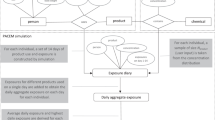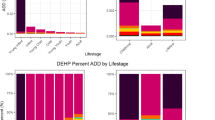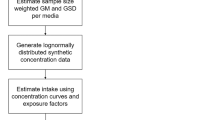Abstract
Copper is an essential trace element and adverse health effects can potentially be associated with both very low and very high intakes. Accurate estimates of inhalation and ingestion (food and drinking water) exposures are therefore needed in order to realistically assess any effects of the distribution of copper intakes within the general population. The work presented here demonstrates an application of a customized subset of the MENTOR/SHEDS-4M computational system (Modeling ENvironment for TOtal Risk studies, employing the Stochastic Human Exposure and Dose Simulation approach, for Multimedia, Multipathway, Multiroute exposures to Multiple co-occurring contaminants. The application utilized data from the National Human Exposure Assessment Survey (NHEXAS) for USEPA Region V as well as from a variety of other available databases. The case study, using a statistical population-based modeling framework, was performed for Eaton County, MI. The results of the simulations, aggregated for six age subgroups of the general population, suggest that food intake is the major pathway for total copper exposure, while drinking water can have significant contributions at the tail of the distribution of intakes. Specifically, it was estimated that over 80% of the county population received potential doses of copper from food that were lower than the Institute of Medicine (IOM) Recommended Dietary Allowance (RDA) value of 900 μg/day. Furthermore, the total combined potential dose from food and water was only about two times greater than the recommended value only for individuals with intakes in the range above the 99th percentile of both food and water intakes. The values were well below the upper tolerable intake value of 10,000 μg/day. The inhalation route consistently acted as only a minor contributor to the total exposure.
This is a preview of subscription content, access via your institution
Access options
Subscribe to this journal
Receive 6 print issues and online access
$259.00 per year
only $43.17 per issue
Buy this article
- Purchase on Springer Link
- Instant access to full article PDF
Prices may be subject to local taxes which are calculated during checkout











Similar content being viewed by others
References
Alexander R.B., Slack J.R., Ludtke A.S., Fitzgerald K.K., and Schertz T.L. Data from selected US Geological Survey National Stream Water Quality Monitoring Networks. Water Resour Res 1998: 34 (9): 2401–2405.
Baker S., Driver J., and McCallum D. Chapter 6: Ingestion exposures in residences. Residential Exposure Assessment, A Sourcebook. Kluwer Academic/Plenum Publishers, Dordrecht/New York, 2001.
Burke J.M., Zufall M.J., and Ozkaynak H. A population exposure model for particulate matter: case study results for PM2.5 in Philadelphia, PA. J Expos Anal Environ Epidemiol 2001: 11: 470–489.
Dwyer J., Ellwood K., Leader N.P., Moshfegh A.J., and Johnson C.L. Integration of the continuing survey of food intakes by individuals and the National Health And Nutrition Examination Survey. J Am Diet Assoc 2001: 101 (10): 1142–1143.
Eilers J.M., Kanciruk P., McCord R.A., Overton W.S., Hook L.A., Blick D.J., Brakke D.F., Kellar P.E., DeHaan M.S., Silverstein M.E., and Landers D.H. Characteristics of Lakes in the Western United States. Volume II: Data Compendium of Site Characteristics and Chemical Variables. EPA/600/3-86/054b. US Environmental Protection Agency, Washington DC, 1987.
Fay R.M., and Mumtaz M.M. Development of a priority list of chemical mixtures occurring at 1188 hazardous waste sites, using the Hazdat database. Food Chem Toxicol 1996: 34 (11–12): 1163–1165.
Georgopoulos P.G., Roy A., Lioy M.J., Opiekun R.E., and Lioy P.J. Environmental copper: its dynamics and human exposure issues. J Toxicol Environ Health, 2001: 4 (Part B): 341–394.
Georgopoulos P.G., Roy A., Yonone-Lioy M.J., Opiekun R.E., and Lioy P.J. Environmental Dynamics and Human Exposure to Copper Volume 1: Environmental Dynamics and Human Exposure Issues. International Copper Association, New York, NY, 2002a.
Georgopoulos P.G., Wang S.W., Vyas V.M., Lioy P.J., Tan H.C., Georgopoulos I.G., and Yonnone-Lioy J. Environmental Dynamics and Human Exposure to Copper Volume 2: Framework and Data Sources for Assessing Human Exposure to Copper in the United States. International Copper Association, New York, NY, 2002b.
Georgopoulos P.G., Wang S.W., Vyas V.M., Sun Q., Burke J., Vedantham R., McCurdy T., and Özkaynak H. A source-to-dose assessment of population exposures to fine PM and ozone in Philadelphia, PA, during a summer 1999 episode. J Expos Anal Environ Epidemiol 2005: 15 (5): 439–457.
Georgopoulos P.G., Wang S.W., Yang Y.C., Xue J., Zartarian V., McCurdy T., and Özkaynak H, Assessing multimedia/multipathway exposures to arsenic using a mechanistic source-to-dose modeling framework. Case studies employing MENTOR/SHEDS-4M. Technical Report CERM:2004-02, Prepared for USEPA (Revised Draft submitted for agency review), 2004: http://ccl.rutgers.edu/reports/cerm/cerm-2004-01_arsenic.pdf.
Grossman J.N . National Geochemical Atlas: The Geochemical Landscape of the Conterminous United States derived from stream sediment and other solid sample media analyzed by the National Uranium Resource Evaluation (NURE) Program. Open-File Report 98-622, US Geological Survey, Reston, VA., 1998: http://geo-nsdi.er.usgs.gov/metadata/open-file/98-622/metadata.faq.html.
IOM. Dietary Reference Intakes for Vitamin A, Vitamin K, Arsenic, Boron, Chromium, Copper, Iodine, Iron, Manganese, Molybdenum, Nickel, Silicon, Vanadium, and Zinc (Chapter 7 – Copper). Institute of Medicine, Food and Nutrition Board, Washington DC, 2001.
Lagos G.E., Maggi L.C., Peters D., and Revco F. Model for estimation of human exposure to copper in drinking water. Sci Total Environ 1999: 239: 49–70.
Lauenstein G.G., and Cantillo A.Y. Sampling and analytical methods of the National Status and Trends Program National Benthic Surveillance and Mussel Watch Projects 1984 to 1992: overview and summary of methods, Volume I, Technical Memorandum NOS ORCA 71, NOAA, Silver Spring, MD, 1993: http://www.ccma.nos.noaa.gov/publications/tm71v1.pdf.
Lioy P.J., and Pellizzari E.D. Conceptual Framework for Designing a National Survey of Human Exposure. J Expos Anal Environ Epidemiol 1995: 5: 425–444.
Maslia M.L., Sautner J.B., Aral M.M., Reyes J.J., Abraham J.E., and Williams R.C. Using water-distribution system modeling to assist epidemiologic investigations. J Water Resour Plann Manag 2000 July/August 2000: 180–198.
McCurdy T., Geln G., Smith L., and Lakkadi Y. The National Exposure Research Laboratory's consolidated human activity database. J Expos Anal Environ Epidemiol 2000: 10: 566–578.
Muller T., Feichtinger H., Berger H., and Muller W. Endemic Tyrolean infantile cirrhosis: an ecogenetic disorder. Lancet 1996: 347 (9005): 877–880.
Muller T., Muller W., and Feichtinger H. Idiopathic copper toxicosis. Am J Clin Nutr 1998: 67 (Suppl): 1082S–1086S.
NRC. Copper in Drinking Water. National Academy Press, Washington DC, 2000, 147.
Pellizzari E.D., Lioy P.J., Quackenboss J., Whitmore R., Clayton A., Freeman N., Waldman J., Thomas K., Rodes C., and Wilcosky T. Population-based exposure measurements in EPA region; a phase-1 field study in support of national human exposure assessment survey. J. Expos Anal Environ Epidemiol 1995: 5: 327–358.
Perwak J., Bysshe S., Goyer M., Nelken L., Scow K., Walker P., Wallace D., and Delos C. An exposure and risk assessment for copper. EPA-440/4-81-015, US EPA, Washington DC, 1980.
Rossman L.A., EPANET 2 Users Manual. EPA/600/R-00/057, USEPA, Water Supply and Water Resources Division, National Risk Management Research Laboratory, Cincinnati, OH, 2000: http://www.epa.gov/ordntrnt/ORD/NRMRL/wswrd/EN2manual.PDF.
Schock M.R., Edwards M., Powers K., Hidmi L., and Lytle D.A. The Chemistry of New Copper Plumbing, Proceedings of the AWWA Water Quality Technology Conference. Salt Lake City, UT, 2000.
Schock M.R., Lytle D.A., and Clement J.A. Effect of pH, DIC, orthophosphate and sulfate on drinking water cuprosolvency. EPA/600/R-95/085, USEPA Office of Research and Development, Cincinnati, OH, 1995: http://www.epa.gov/ORD/WebPubs/effect.
Sexton K., Kleffman D.E., and Callahan M.A. An introduction to the National Human Exposure Assessment Survey (NHEXAS) and related phase 1 field studies. J Expos Anal Environ Epidemiol 1995: 5: 229–232.
Tanner M.S. Role of copper in Indian childhood cirrhosis. Am J Clin Nutr 1998: 67 (5 Suppl): 1074S–1081S.
Tao S.H., and Bolger P.M. Dietary arsenic intakes in the United States: FDA Total Diet Study, September 1991 — December 1996. Food Addit Contam 1998: 16 (11): 465–472.
Tippett K.S. Food consumption surveys in the US Department of Agriculture. Nutr Today 1999: 34 (1): 33–46.
USCB. Profiles of General Demographic Characteristics. 2000 Census of Population and Housing, Michigan, United States Census Bureau, 2001: http://www.census.gov/census2000/states/mi.html.
USEPA. Monitoring requirements for lead and copper in tap water. Fed Regist 1991: 56 (110) US EPA.
USEPA. Drinking water maximum contaminant level goals and national primary drinking water regulations for lead and copper. Fed Regist 59 (125) US EPA, 1994.
USEPA. Information available from the Safe Drinking Water Information System (website): http://www.epa.gov/safewater/sdwisfed/sfed2.html, 1998.
USEPA. 1999 Toxic Release Inventory Public Data Release. EPA 260-R01-001. USEPA Office of Environmental Information (2810) Washington DC, 2001a.
USEPA. AIRS User's Guide. USEPA Office of Air Quality Planning and Standards, Research Triangle Park, NC, 2001b.
USEPA. Manual for the Certification of Laboratories Analyzing Drinking Water, Fifth Edition, Chapter IV Critical Elements for Chemistry, Table IV-7 MCLs and Detection Limits Requirements in the CFR (mg/L) to composite (http://www.epa.gov/safewater/labcert/pdfs/manual_labcert_2005.pdf). EPA 815-R-05-004, USEPA, 2005.
USEPA. Safe Drinking Water Information System/Federal Version. http://www.epa.gov/safewater/sdwisfed/sdwis.htm, 2005.
USFDA. Total diet study. http://vm.cfsan.fda.gov/~comm/tds-toc.html, 2004.
USGS. USGS National Water Quality Assessment Data Warehouse. USGS Water Resources Division, 2004: http://infotrek.er.usgs.gov/servlet/page?_pageid=543&_dad=portal30&_schema=PORTAL30.
Whitmore R.W., Byron M.Z., Clayton C.A., Thomas K.W., Zelon H.S., Pellizzari E.D., Lioy P.J., and Quackenboss J.J. Sampling design, response rates, and analysis weights for the National Human Exposure Assessment Survey (NHEXAS) in EPA Region 5. Expos Anal Environ Epidem 1999: 9 (5): 369–380.
Xue J. Personal Communication. USEPA Office of Pesticide Programs. Research Triangle Park, NC, 2003.
Acknowledgements
Support for this work has been provided by the International Copper Association (Project TPT0619A/BB-00), and the results presented here have been derived from and expanded upon the information presented in ICA Publication “Environmental Dynamics of Copper and Human Exposure to Copper — Volume 2” (Georgopoulos et al., 2002b). The methods and computational tools used for the implementation of the study described here have been developed by the US EPA funded Center for Exposure and Risk Modeling (CERM) at EOHSI (EPA CR-827033), and the NIEHS Center Grant at EOHSI (P30ES05022). We extend our appreciation to our project officers, Dr. Scott Baker and Mr. Michael Hennelly, of the International Copper Association, for valuable data and other information they have provided in relation to this work as well as for their helpful comments and insights and to Linda Everett of the Computational Chemodynamics Laboratory for preparation of manuscript and graphics.
Author information
Authors and Affiliations
Corresponding author
Rights and permissions
About this article
Cite this article
Georgopoulos, P., Wang, S., Georgopoulos, I. et al. Assessment of human exposure to copper: A case study using the NHEXAS database. J Expo Sci Environ Epidemiol 16, 397–409 (2006). https://doi.org/10.1038/sj.jea.7500462
Received:
Accepted:
Published:
Issue Date:
DOI: https://doi.org/10.1038/sj.jea.7500462
Keywords
This article is cited by
-
Red-emission carbon dots as fluorescent “on–off–on” probe for highly sensitive and selective detection of Cu2+ and glutathione
Analytical and Bioanalytical Chemistry (2022)
-
Copper(II) and lead(II) adsorption onto zinc sulfide nanoparticles effects of light, pH, time, temperature, and interferences
International Journal of Environmental Science and Technology (2022)
-
Effects of Copper Supplementation on Blood Lipid Level: a Systematic Review and a Meta-Analysis on Randomized Clinical Trials
Biological Trace Element Research (2021)
-
Development of dual function polyamine-functionalized carbon dots derived from one step green synthesis for quantitation of Cu2+ and S2− ions in complicated matrices with high selectivity
Analytical and Bioanalytical Chemistry (2020)
-
Biologically based modeling of multimedia, multipathway, multiroute population exposures to arsenic
Journal of Exposure Science & Environmental Epidemiology (2008)



